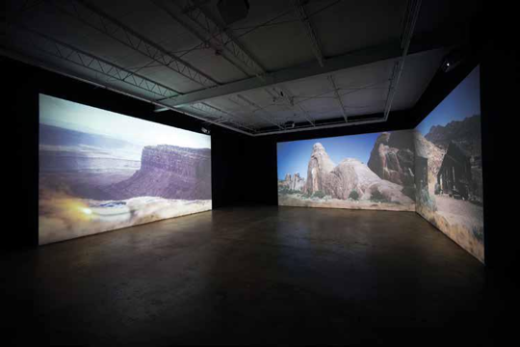Cara Despain: Slow Burn
Erin Thurlow

Cara Despain, Slow Burn, 2016. Four-channel video installation, dimensions variable
March 16–April 23, 2016
Entering Cara Despain’s recent show at Spinello Projects, before the eyes have a chance to adjust, felt like walking out of the glare of the afternoon sun and into a matinee. A theater light created a spot on a clay horse head lying on the floor. But everything else was black. The spot that bends from the floor formed a half-circle of setting sun on the wall. In its glare, the unpainted ceramic decapitation looked like the sun-bleached remains of an anonymous massacre. It was also an immediately recognizable allusion to The Godfather (and American marquee movies!). By framing the head in the spotlight, the elements of Francis Ford Coppola’s immigrant epic are condensed into a singular conflation of the entire movie: the opera stage, the nightclub singer, and the death sentence of the Mafia’s internecine struggles, a good old spoiled American dream. No surprise then that in the next room there was another allusion to another pillar of American cinema, the Western.
Each wall of this gallery became a screen filled with a projection, creating an immersive, fractured panorama: three stunning views of a desert valley and an appropriately dilapidated structure, an old trading post or a mining colony. All the views were static. The only movement was the sputtering end of a lit fuse crawling across the foreground, left to right, slowly making its way across all four walls, “reading” the landscape, as the viewer waits for the big bang. Eventually, however, the fuse simply repeats its cycle, in an infinite loop. While Despain’s video installation recalls a familiar trope from so many Hollywood cliffhangers (and Wile E. Coyote and the Road Runner!), it also postulates the cinematic opposite of the literally explosive ending of Michelangelo Antonioni’s Zabriskie Point (1970), another movie set in another dessert in the American West, this one by an Italian that could be considered Coppola’s cinematic uncle. While Antonioni gave us the apocalypse we’d been yearning for all along, Despain shows how that release can be forestalled, keeping us trapped in an oh-so-American, permanent state of desire. Despain explores the American landscape through its cinematic double. Just as Hollywood cinema is the product of the American West, “the West” is a product of Hollywood.










